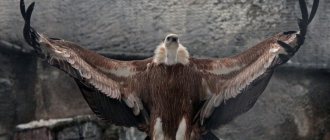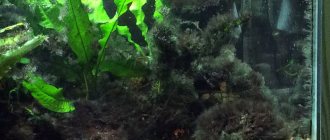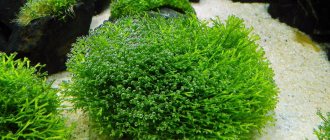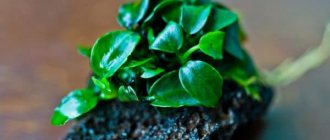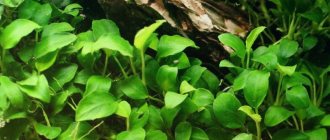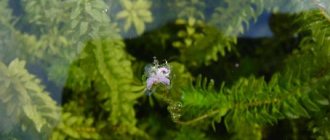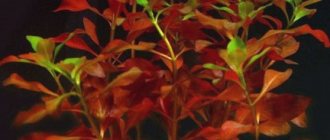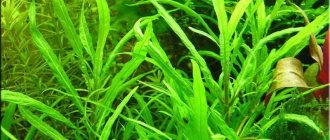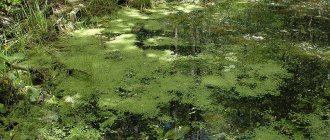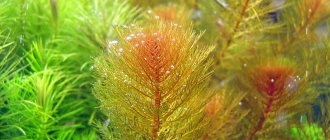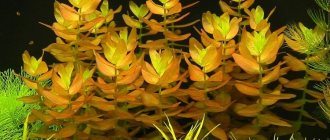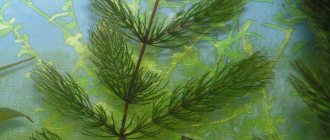Home › Aquarium plants › Catalog of aquarium plants ›
( 3 ratings, average: 4.00 out of 5)
Hydrocotyle leucocephala was found in the swamps of Southern Mexico and Northern Argentina, a very common and affordable, extremely unpretentious aquarium plant.
Description
This plant is native to tropical waters in South America. It itself is quite unpretentious, but it takes root best in stagnant waters. It grows especially strongly in areas where there is silt and organic matter at the bottom.
Visually, the hydrocotila looks quite attractive. It has delicate stems that reach a height of up to 50 cm. The leaf is round, quite large, up to 4 cm in diameter. All parts of the bush have a green color. Some varieties have a brighter, light green color. The stem can grow in two ways. The first is upright growing, when the plant protrudes directly from the water. The second is creeping, in which it spreads along the bottom.
The leaves are attached to the stem using petioles. They can be either round or divided into lobes, interconnected in the center. In some species, the foliage has jagged edges.
Habitat in nature
The natural habitat of the tripartite moss is water bodies and constantly moist areas of the tropical regions of Asia. Aquatic systems favorable for crop growth:
- lakes;
- ponds;
- marshy, muddy water areas;
- slow flowing rivers.
Hydrocotyla tripartite requires fresh water at a constant temperature.
Content
Hydrocotyla in an aquarium will not cause any problems, since it is unpretentious and will easily take root both in a small container and a large artificial reservoir. All she needs for active growth is:
Water parameters . The main condition for hydrocotyle is compliance with the temperature regime. In nature, it is found in tropical climates, so it therefore needs warm water. The optimal parameter is 18-28 degrees. At excessively low temperatures, growth stops and the bush itself may die. As for hardness and acidity, they do not matter. It is also advisable to periodically change the water. This will reduce the concentration of nitrates and phosphates, and will also give the plant an impetus for growth;
Lighting . It should be bright, since the shieldwort is accustomed to the bright tropical Sun. It is desirable that the intensity be at least 0.5 W/l. In poor lighting, the leaves become smaller and the stems gradually begin to die. As for the type of lamp, LEDs or fluorescent lamps work well. They provide a wide color range and do not emit heat, which will have a positive effect on the growth rate of the plant;
Soil . It also doesn't really matter. You can choose either sand or gravel as a substrate. You can also choose basalt, quartz, granite, etc. The fraction is also secondary, but fine soil is better because it will be easier to plant plants in it;
Feeding . Today, many aquarists use fertilizers to speed up the growth of plants in the aquarium. However, the shield leaf does not need UDO, since it has enough nutrients that are formed naturally.
We recommend reading the article: Japanese Blixa: maintenance and care
Care
No special skills are required to grow and care for rosemary. Please note a few points:
- Replacing some of the water required by any aquarium inhabitants will give the plant the freshness and nutrients it needs.
- Careful handling will keep the fragile stems undamaged.
- Compliance with the temperature and light conditions will help the rosemary feel comfortable and stimulate growth.
- The plant will receive fertilizers added to the water using aerial roots.
- Hydrocotyla planted in open ground is transferred to a warm, well-lit place for the winter.
- Shield leaf is resistant to diseases and pests.
- Remove excess plants to avoid filling the entire aquarium.
Pleasant shape, low maintenance requirements and rapid growth are factors that designers take into account when choosing white-headed shieldwort to decorate the aquarium and provide the fish with suitable living conditions. Combines with almost all inhabitants of the aquarium. Suitable for people without experience in growing aquatic plants.
Reproduction and planting
This process is also not particularly complicated. Reproduction is carried out through cuttings. Under optimal conditions (mainly related to light intensity and daylight hours), the bush will produce a young shoot.
The aquarist can only wait until 5-6 leaves appear on it, after which the bush can be separated and planted. In general, hydrocotyla is so unpretentious that even an accidentally detached shoot with just 1 leaf can survive and grow. But, of course, it is advisable to let him get the maximum nutrients from the mother bush.
As for landing, it is not particularly difficult. Most lovers of underwater flora and fauna simply leave it in the water column. The shield leaf absorbs nutrients not through the roots, but through its surface as a whole. In fact, it only needs the root system to stay in the ground. Therefore, you should not bury the bush too much. It is enough to simply press it down lightly with a stone so that it does not float up. Then the stems and leaves will grow along the ground and form beautiful thickets.
Name variations
There are several alternative names:
- Trififolia;
- Hydrocotyla Japan;
- Hydrocotyle sp. "Japan";
- Hydrocotyla Trilobed.
But the botanical name is Hydrocotyla Tripartita.
Kinds
Today there are many varieties of this plant. However, the following types are especially popular:
Tripartita
It is often classified as ground cover plants. Of course, it can provide good growth in the lower part of the aquarium. However, in its essence, the type of tripartite is not such. “Ground cover” is characterized by the fact that it sends out stems along the ground and takes root on its own. This hydrocoil does not cling to stones. Only those parts that are near it are buried in the substrate. The rest will strive for thicker water, because that’s where they feel best. This species differs from others in its miniature size. The leaves grow to only 1.5 cm. They are on a small stalk up to 3 cm;
White-headed
It has larger and rounded leaves. It can also either float around the aquarium or be rooted. Looks impressive towards the back of the aquascape. However, it is better not to plant it and leave it near the surface, where the plant will grow roots and the leaves will begin to emerge above the water, creating a thick floating carpet;
Useful lifehacks
To promote the life of the plant, we offer advice from experienced aquarists:
- With good humidity, the plant can be grown in a regular pot.
- If the leaf blades turn yellow and holes form on them, hydrocotila is experiencing a lack of mineral fertilizers.
- A lack of carbon dioxide leads to the formation of a white coating on the leaves.
- It is not advisable to add fertilizers for indoor plants to water. This can lead to excessive algae growth.
Planting
If you do not know the characteristic features of this plant, then planting it in an aquarium can create some problems. You can try for a long time to plant young shoots of hydrocotyl in the ground, but the result will only be to break the tender trunks and roots and thereby destroy the sprouts.
Aquarists have experimentally found an original solution: a bunch of shieldwort is simply placed on the bottom of the container and pressed down with a pebble or some other light object. Soon a bright green bush grows from this bunch.
The structure and quality of the soil for growing hydrocotyl does not matter. The recommended water temperature for young shoots is from +22 to +28 degrees, as for most ornamental fish.
Some people insert a small bunch of hydrocotyl into a crack in a piece of driftwood in the aquarium. Over time, the overgrown stems with leaves envelop this object with a plant carpet.
There is no specific recommended place for planting tripartite. Her caps can be seen both in the center and in the background of the fish tank.
Compatibility
Hydrocotyla is a non-toxic green, so it can be safely planted in an aquarium with fish and other inhabitants. Do not combine tall vegetation with wide leaves with rosemary, because hydrocotyle will not have enough light and its color will fade. The shield leaf itself is capable of blocking the light with low-growing greenery. Vegetation of medium height is best suited for joint planting:
- Ammania senegalese.
- Aponogeton curly.
- Common cabomba.
- Cryptocoryne Hertel.
- Horny fern.
Shieldfoils Sibthoriodes
It is often used as an ornamental plant, as the leaves have a beautiful, carved shape. It grows naturally in the southeast Asian regions. It is difficult to cultivate, very capricious and demanding of living conditions.
The stems range in size from 12 to 45 cm, and the leaves are very small (0.4-2.2 cm). It can grow along the bottom of a reservoir or upward to the surface.
Aquarium maintenance requires good lighting and regular feeding with carbon dioxide. Acidity should be at the level of 5.5-7.8 pH, and the water temperature should be +19...+29 °C.
Diseases
Basically, all diseases of stinkwort are caused by nutrient deficiency or critical physicochemical parameters of water.
| Symptom | Description | Causes |
| Decrease in decorativeness | Loss of color intensity; stems are overly elongated and poorly leafy | Insufficient lighting |
| Withering | Loss of healthy appearance; leaves are limp, drooping, frayed edges; reduced turgor | Unsuitable water chemistry parameters |
| Stopped development | Growth stops; color intensity decreases | Unsuitable physical and chemical parameters of water, CO2 deficiency |
| Changes in leaf color | Yellow or red leaves | Deficiency of macroelements, most often nitrogen, sulfur |
| Changes in the color of the edge of the leaf blade | The edge of the leaf turns yellow or red | Deficiency of macronutrients, usually calcium |
| Leaf damage | Holes and necrotic areas form on healthy leaves, followed by loss of the organ. | Deficiency of macro- or microelements, most often phosphorus, potassium |
| White plaque | The plant is covered with a whitish coating | CO2 deficiency |
To accurately determine the reasons for the unhealthy state of the plant, it is recommended to monitor aquarium water with special test systems (submersible, drip, electronic).
Since tripartita is a hydrophilic plant, fertilizers in liquid form are used to quickly compensate for the deficiency of macro- and microelements. In this case, soil feeding will be less effective.
Hydrocotyla tripartita is a rather delicate plant and is susceptible to diseases if not properly cared for.
Plant cost
Trifid foxtail is sold in pet stores, in places where aquarium paraphernalia are sold, and on online trading platforms. The cost is different everywhere and depends on the degree of development of the plant and the pricing policy of the seller.
| Hydrocotyla tripartite | Average cost, in rubles |
| Cuttings | 100 |
| Small young bush | 150-220 |
| Mature overgrown plant | 250-500 |
Online stores carefully pack the plant and send it to the delivery region by transport companies.
You can purchase the plant at a regular pet store or in an online store.
